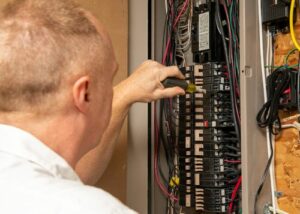What Are The Best Lighting Options For Decks?
You know that feeling when you’ve spent all day working on your deck, maybe grilling with friends or just enjoying a quiet evening outside, and then the sun starts to set? Suddenly, your beautiful outdoor space becomes… well, invisible. I’ve been there more times than I’d like to admit.
After years of helping homeowners figure out their outdoor lighting needs, I can tell you this: the right lighting options can completely transform how you use your deck. We’re not just talking about slapping a floodlight on the back of your house and calling it good. There’s a whole world of lighting options that can make your deck both functional and gorgeous after dark.
Why Deck Lighting Actually Matters
Let’s be real here. Most people think about deck lighting as an afterthought something you consider only after you’ve tripped down the stairs one too many times. But good lighting does so much more than just prevent accidents (though that’s obviously important too).
The right lighting options extend your outdoor living season, create ambiance for entertaining, and, honestly, make even a basic deck look like something out of a home and garden magazine. I’ve seen simple string lights turn a plain wooden platform into the kind of space where people want to linger.
Safety’s obviously a big factor too. Nothing ruins a backyard gathering like someone taking a tumble because they couldn’t see where the steps were.
Breaking Down Your Main Lighting Options
Post Cap Lights – The Classics That Never Go Out of Style
These little guys sit right on top of your deck posts, kind of like tiny lighthouses guiding you around your outdoor space. I love recommending post cap lights because they’re versatile—you can find them in everything from traditional lantern styles to sleek modern designs.
The beauty of post caps is they provide that ambient glow without being too aggressive. They mark the perimeter of your deck without making it feel like you’re dining under stadium lights. Most of the lighting options in this category use LED bulbs now, which means they’ll last forever and won’t jack up your electric bill.
Step Lighting – Because Nobody Wants to Eat Deck
Okay, this might be the most practical of all the lighting options we’ll talk about. Step lights get installed right into your stair risers or along the sides of each step. They’re low-profile, they’re effective, and they can save you from some seriously embarrassing (and painful) falls.
I usually recommend going with warm white LEDs for step lighting. The goal isn’t to create a runway—you just want enough light so people can see where they’re going. Some of the newer models even have motion sensors, which is pretty slick if you ask me.
Recessed Deck Lights – For the Minimalist Look
If you’re going for that clean, uncluttered aesthetic, recessed lights might be your best bet. These get installed flush with your decking material, so they don’t stick out or get in the way. They’re tough enough to handle foot traffic, and they give off this subtle glow that’s really nice.
The installation’s a bit more involved with recessed lighting options, since you’re actually cutting holes in your deck. But the end result? Worth it. Especially if you’ve got a modern home where you don’t want the lighting to compete with your architecture.
String Lights – The Party Starters
I’ll admit it—I’m a sucker for string lights. There’s something about them that just makes everything feel more… festive? Cozy? I’m not sure what the right word is, but you know what I mean.
You can hang them from railings, string them between posts, or drape them overhead if you’ve got a pergola or awning. The lighting options here are pretty endless—Edison bulbs for that vintage vibe, or color-changing LEDs if you want to get fancy.
Just make sure you’re getting outdoor-rated strings. Trust me on this one. I’ve seen too many people learn this lesson the hard way after the first rain.
Under-Rail Lighting – The Secret Weapon
This is one of those lighting options that people don’t think about until they see it in action. Under-rail lights mount underneath your deck railing and cast light downward. They illuminate your deck surface without creating glare, and they give everything this really sophisticated look.
Plus, they’re kind of hidden during the day, so they don’t mess with your deck’s daytime appearance. It’s like having invisible lighting that only shows up when you need it.
Solar vs. Low-Voltage vs. Line Voltage – The Power Question
Here’s where things get a little technical, but stick with me because this matters for your budget and your long-term happiness with your lighting options.
Solar Lights – The Easy Button
Solar lighting options are tempting because they’re simple. No wiring, no electrician, no permits. You just stick them where you want them and let the sun do its thing.
The downside? They’re only as good as the sunlight they get during the day. If your deck’s in a shady spot, or if you live somewhere that doesn’t get consistent sun, solar might leave you disappointed. Also, the light output is usually pretty limited compared to other options.
Low-Voltage Systems – The Sweet Spot
Most of the lighting options I recommend fall into this category. Low-voltage systems run off a transformer that plugs into a regular outlet, but they step the power down to 12 volts. This makes them safer to work with and more energy-efficient than line voltage.
You get better light output than solar, more control over brightness and timing, and the installation isn’t too crazy. It’s kind of the goldilocks zone of deck lighting.
Line Voltage – When You Need the Big Guns
Sometimes you need full 120-volt power—maybe for higher-output fixtures or for integrating with your home’s main lighting system. Line voltage lighting options give you the most flexibility and power, but they also require a licensed electrician and usually permits.
Planning Your Deck Lighting Layout
This is where a lot of people go wrong. They pick out pretty fixtures without thinking about how the whole system will work together. The best lighting options are the ones that create layers of light—some for safety, some for ambiance, some for task lighting if you’ve got an outdoor kitchen or dining area.
Start with safety lighting first. Where are your stairs? Are there any level changes people need to see? Any obstacles they might trip over? Get those areas covered, then think about the mood lighting.
Don’t forget about light pollution either. Your neighbors probably don’t want your deck lights shining into their bedroom windows. Good lighting options direct light where you need it, not where you don’t.
Installation – DIY or Call the Pros?
Look, I’m all for DIY projects when they make sense. Installing solar stake lights along a garden path? Go for it. Hanging some string lights from existing hooks? Have at it.
But when you start talking about cutting holes in your deck for recessed lights, or running new electrical circuits, or dealing with anything that involves your home’s main electrical panel… that’s when you want to call in someone who knows what they’re doing.
The good news is that most lighting contractors are pretty reasonable about smaller jobs like deck lighting. And the peace of mind of knowing everything’s wired correctly and safely? That’s worth something.
Wrapping It All Up
The best lighting options for your deck are the ones that fit your lifestyle, your budget, and your space. Maybe that’s simple solar post caps for a small deck where you just want to see the stairs at night. Maybe it’s a full low-voltage system with recessed lights, step lighting, and accent fixtures for a large entertaining space.
The key is to think about how you actually use your deck, plan for both safety and ambiance, and don’t be afraid to mix different types of lighting options and colors to get the effect you want.
And remember—you can always start simple and add more later. Deck lighting is one of those things where you can build your system over time as your needs change or your budget allows. Your deck deserves to be enjoyed after dark. The right lighting will make that happen.

